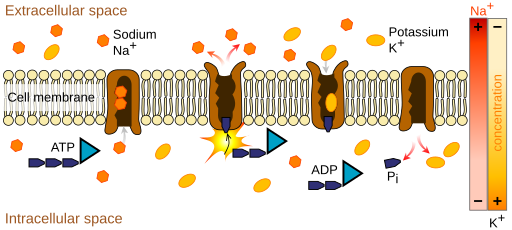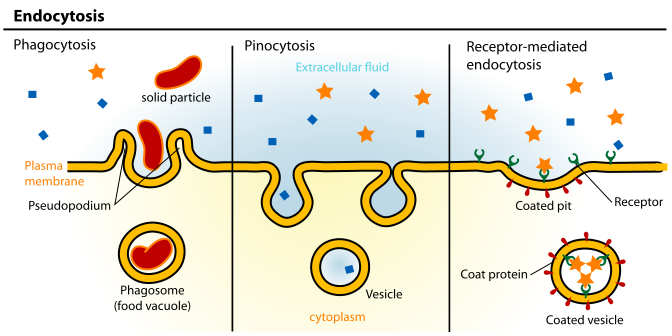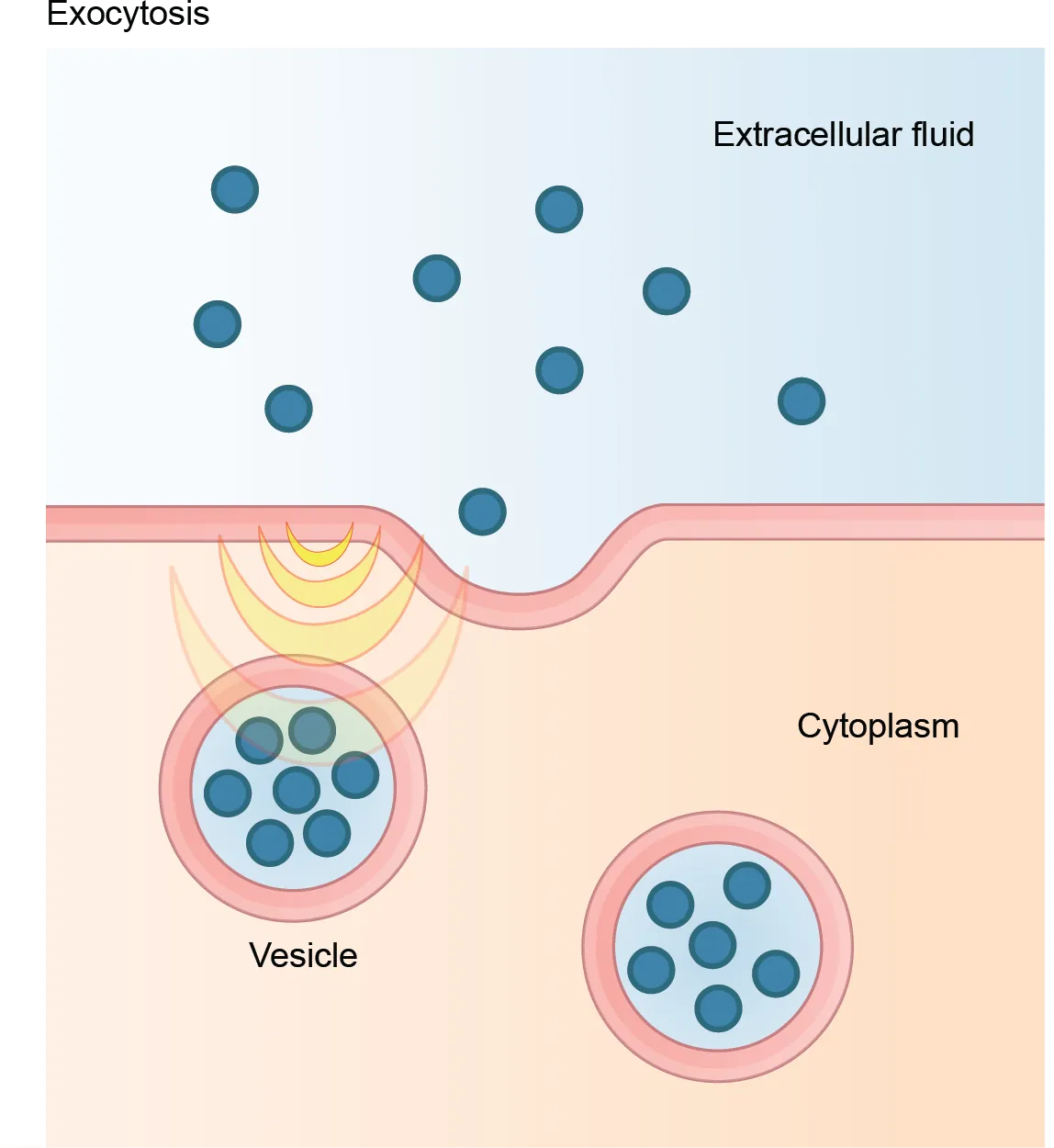OCR Specification focus:
‘Describe ATP-dependent transport processes: active transport, endocytosis and exocytosis.’
Active transport and bulk transport processes enable cells to move substances against concentration gradients or in large quantities. These mechanisms require adenosine triphosphate (ATP) and are essential for maintaining cellular homeostasis.
Active Transport
Active transport is the movement of molecules or ions across a membrane against their concentration gradient, from an area of lower concentration to higher concentration, requiring metabolic energy in the form of ATP.
Primary and Secondary Active Transport
There are two main types of active transport mechanisms:
Primary active transport: Direct use of ATP to power molecular movement.
Secondary (indirect) active transport: Utilises energy stored in the electrochemical gradient created by primary active transport.
The Sodium–Potassium Pump
The most well-known example of active transport is the sodium–potassium (Na⁺/K⁺) pump, found in the plasma membrane of animal cells.

Labeled diagram of the sodium–potassium pump illustrating ATP binding and hydrolysis, conformational change, and the 3 Na⁺ out / 2 K⁺ in ion exchange per cycle. This exemplifies primary active transport, where ATP directly powers a carrier protein (“pump”). The figure is concise and uncluttered, suitable for A-level revision. Source.
Pumps 3 Na⁺ ions out of the cell and 2 K⁺ ions in for every ATP molecule hydrolysed.
Maintains an electrochemical gradient, essential for processes such as nerve impulse transmission and osmotic balance.
Active transport: The movement of molecules or ions across a membrane from a region of lower to higher concentration, using energy derived from ATP and specific carrier proteins.
Mechanism of Active Transport
Molecule binds to a specific carrier protein (also called a pump).
ATP binds to the carrier and is hydrolysed to ADP and Pi (inorganic phosphate).
The energy released changes the shape of the carrier protein.
The molecule or ion is released on the opposite side of the membrane.
The carrier returns to its original shape as Pi detaches.
EQUATION
—-----------------------------------------------------------------
ATP Hydrolysis = ATP → ADP + Pi + Energy
ATP (adenosine triphosphate) = Cellular energy molecule
ADP (adenosine diphosphate) = Product formed when one phosphate is removed
Pi (inorganic phosphate) = Released phosphate ion contributing to energy release
—-----------------------------------------------------------------
This process ensures that even when diffusion is unfavourable, essential substances such as glucose, amino acids, and ions are transported efficiently into or out of cells.
Endocytosis
Endocytosis is the bulk transport of materials into the cell via the plasma membrane. It allows large molecules or particles, which cannot pass through the membrane by diffusion or active transport, to enter the cell.
Endocytosis: The process by which a cell engulfs material from its environment by enclosing it in a membrane-bound vesicle.
Types of Endocytosis
There are two main forms:

Schematic comparing phagocytosis (engulfment of large particles), pinocytosis (uptake of extracellular fluid), and receptor-mediated endocytosis (selective cargo capture via membrane receptors). Labels show membrane invagination, vesicle formation, and cargo specificity. Extra detail: receptor-mediated endocytosis appears here for completeness even though only phagocytosis and pinocytosis were described in the text. Source.
Phagocytosis (“cell eating”): Ingestion of large particles such as bacteria or dead cells.
The plasma membrane extends around the particle, forming pseudopodia.
The enclosed material forms a phagosome that fuses with a lysosome for digestion.
Common in phagocytic white blood cells like macrophages.
Pinocytosis (“cell drinking”): Uptake of liquids and small molecules.
The plasma membrane invaginates to form small vesicles containing extracellular fluid.
This process occurs continuously in most animal cells.
Energy Requirement and Vesicle Formation
Both processes rely on ATP for:
Membrane invagination and vesicle formation.
Cytoskeletal movement (especially microfilaments and microtubules).
Transport of vesicles within the cytoplasm after uptake.
The vesicles formed move to specific cellular destinations where their contents are processed or digested.
Exocytosis
Exocytosis is the bulk transport of materials out of the cell, used to secrete substances such as enzymes, hormones, or waste products.

Diagram of exocytosis showing vesicle trafficking to the plasma membrane, membrane fusion, and release of cargo to the extracellular space. Arrows indicate the direction of movement, emphasising that this is an active, ATP-dependent process mediated by the cytoskeleton. The layout is intentionally simple and uncluttered for rapid revision. Source.
Exocytosis: The process by which substances contained in vesicles are expelled from a cell as the vesicle membrane fuses with the plasma membrane.
The Process of Exocytosis
Vesicle formation: Substances are packaged into membrane-bound vesicles by the Golgi apparatus.
Vesicle transport: Vesicles move along the cytoskeleton to the cell surface.
Fusion: The vesicle membrane fuses with the plasma membrane in an ATP-dependent process.
Release: The contents are released into the extracellular space.
Membrane recycling: The vesicle membrane becomes part of the plasma membrane or is recycled back to the Golgi.
Biological Importance
Neurotransmitter release at synapses.
Secretion of digestive enzymes from gland cells.
Release of hormones such as insulin from pancreatic cells.
Removal of cellular waste and damaged organelles.
These processes are vital for intercellular communication and maintaining cell function.
Comparison of Active Transport, Endocytosis and Exocytosis
Energy Use
All three mechanisms are ATP-dependent, classifying them as active processes. ATP provides the energy needed for carrier protein conformational changes (in active transport) and for membrane movement (in endo- and exocytosis).
Direction of Transport
Active transport moves individual ions or molecules through specific carrier proteins.
Endocytosis moves bulk material into the cell.
Exocytosis moves bulk material out of the cell.
Structural Involvement
Active transport involves intrinsic membrane proteins acting as pumps.
Endocytosis and exocytosis involve membrane vesicles and cytoskeletal components such as microtubules and actin filaments.
The Role of the Cytoskeleton in Vesicle Transport
The cytoskeleton provides structural support and a transport network for vesicles.
Microtubules act as “tracks” along which motor proteins such as kinesin and dynein transport vesicles.
Microfilaments (actin filaments) assist in membrane deformation during vesicle budding and fusion.
ATP hydrolysis powers these motor proteins, ensuring directional movement of vesicles.
This integration between energy use, membrane dynamics, and cytoskeletal activity demonstrates how cells coordinate transport processes to maintain homeostasis and communication.
FAQ
Active transport maintains electrochemical gradients by moving ions against their concentration gradients. For instance, the Na⁺/K⁺ pump actively removes sodium ions from the cell while importing potassium ions.
This balance:
Prevents osmotic swelling or shrinkage of cells.
Maintains membrane potential for nerve impulse transmission.
Enables secondary transport processes, such as glucose absorption in the small intestine.
Vesicle movement is guided by the cytoskeleton and motor proteins.
Microtubules act as intracellular “tracks”.
Motor proteins such as kinesin and dynein attach to vesicles and move them using energy from ATP hydrolysis.
Signal molecules and membrane receptors ensure vesicles reach the correct target membrane (e.g. lysosome, plasma membrane).
This precise coordination prevents cellular traffic errors and ensures efficient material transport.
During endocytosis and exocytosis, specific membrane proteins assist in vesicle formation and fusion.
Clathrin forms a coated pit to help shape the vesicle during endocytosis.
SNARE proteins enable vesicle docking and fusion with target membranes during exocytosis.
Receptor proteins on the membrane bind to particular substances for receptor-mediated endocytosis.
These proteins ensure the processes are selective and energy-efficient.
If exocytosis stopped, the cell could not secrete essential materials or remove waste.
Consequences include:
Hormones and enzymes would not be released, disrupting metabolism and communication.
Neurotransmitters would accumulate in neurons, impairing nerve signalling.
Build-up of toxic materials inside the cell could cause damage or apoptosis.
Normal cell functioning depends on continuous and controlled exocytosis.
Endocytosis is more common in animal cells than in plant cells because the rigid cell wall restricts large-scale membrane invagination in plants.
However:
Plant cells use plasmodesmata for communication and exchange of small molecules.
Some plant cells exhibit limited clathrin-mediated endocytosis for nutrient uptake or hormone regulation.
Thus, while both cell types can internalise materials, the extent and mechanisms differ due to structural constraints.
Practice Questions
Question 1 (2 marks)
Describe one similarity and one difference between active transport and facilitated diffusion.
Mark scheme:
1 mark for similarity: both involve the use of carrier proteins or transport proteins in the plasma membrane.
1 mark for difference: active transport requires ATP (metabolic energy) and moves substances against the concentration gradient, whereas facilitated diffusion is passive and moves substances down the concentration gradient.
Question 2 (5 marks)
Explain the roles of ATP and the cytoskeleton in the processes of endocytosis and exocytosis.
Mark scheme:
Award up to 5 marks for the following points:
1 mark: ATP provides the energy needed for vesicle formation and movement.
1 mark: During endocytosis, ATP is required for membrane invagination and vesicle formation.
1 mark: During exocytosis, ATP powers the fusion of vesicles with the plasma membrane.
1 mark: The cytoskeleton, particularly microtubules and microfilaments, provides tracks along which vesicles move.
1 mark: Motor proteins (e.g. kinesin, dynein) use energy from ATP hydrolysis to transport vesicles to or from the cell surface.

